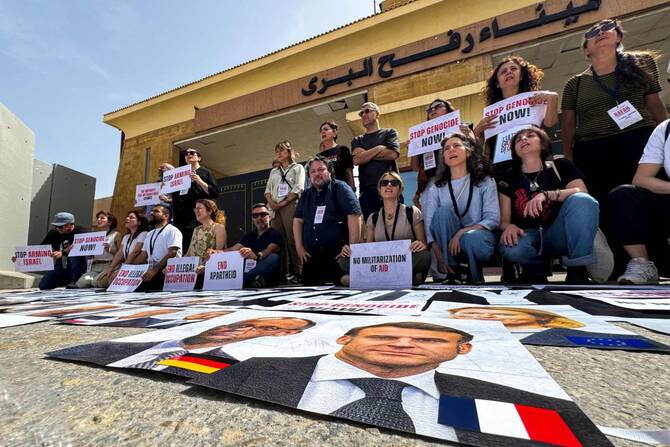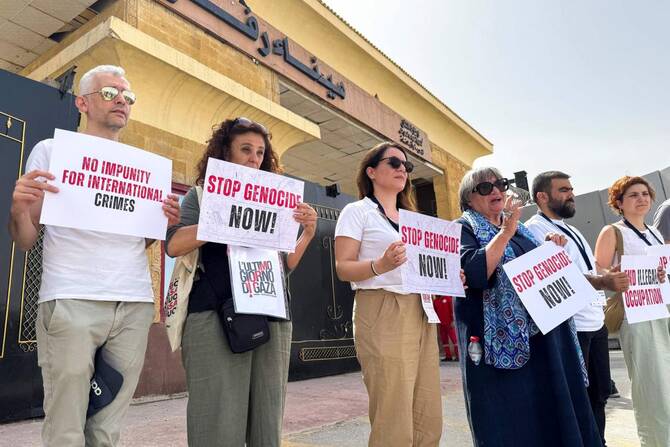RAFAH: Italian parliamentarians protested on Sunday in front of Egypt’s Rafah border crossing with Gaza, calling for aid access and an end to the war in the devastated Palestinian territory.
“Europe is not doing enough, nothing to stop the massacre,” Cecilia Strada, an Italian member of the European parliament, told AFP.
The group — including 11 members of the Italian parliament, three MEPs and representatives of NGOs — held signs reading “Stop genocide now,” “End illegal occupation” and “Stop arming Israel.”
“There should be a complete embargo on weapons to and from Israel and a stop to trade with illegal settlements,” Strada said.
The protesters laid toys on the ground in solidarity with Gaza’s children, who the UN warns face “a growing risk of starvation, illness and death” more than two months into a total Israeli aid blockade.
At least 15,000 children have been killed in Gaza since the Israel-Hamas war began in October 2023, according to the United Nations.
Israel has faced mounting pressure to lift its aid blockade, as UN agencies warn of critical shortages of food, clean water, fuel and medicines.
It resumed its offensive on March 18, ending a two-month truce in its war against Hamas triggered by the Palestinian militant group’s October 2023 attack on Israel.
On Saturday Israel announced an expanded military campaign, killing dozens of people in new strikes.
“We hear the bombs right now,” Walter Massa, president of Italian non-profit organization Associazione Ricreativa Culturale Italiana, told AFP near the crossing.
“The Israeli army continues to do what it believes is right in the face of an international community that does not intervene, and in Gaza, beyond the Rafah crossing border, people continue to die,” he said.
UN chief Antonio Guterres said Saturday said he was “alarmed” at the escalation and called for “a permanent ceasefire, now.”
Italy’s government on Saturday reiterated its calls to Israel to stop attacking Gaza, with Foreign Minister Antonio Tajani saying: “Enough with the attacks.”
“We no longer want to see the Palestinian people suffer,” Tajani said.
Gaza’s health ministry said Sunday 3,193 people have been killed since Israel resumed its strikes on March 18, taking the war’s overall toll to 53,339.
Italian MPs protest at Egypt’s Gaza border against war
https://arab.news/bdbup
Italian MPs protest at Egypt’s Gaza border against war

- The group — including 11 members of the Italian parliament, three MEPs and representatives of NGOs — held signs reading “Stop genocide now”
Syrian government announces ceasefire in Aleppo

- Syrian government forces have been fighting the Kurdish-led SDF force in Aleppo, where at least 21 people have been killed in several days of clashes
DAMASCUS: Damascus: Syria’s defense ministry announced a ceasefire in several neighborhoods of Aleppo on Friday after days of deadly clashes with Kurdish fighters.
“To prevent any slide toward a new military escalation within residential neighborhoods, the Ministry of Defense announces ... a ceasefire in the vicinity of the Sheikh Maqsoud, Alashrafieh, and Bani Zeid neighborhoods of Aleppo, effective from 3:00 am,” the ministry wrote in a statement.
Syrian government forces have been fighting the Kurdish-led SDF force in Aleppo, where at least 21 people have been killed in several days of clashes.
Both sides have traded blame over who started the clashes on Tuesday, which comes as implementation stalls on a deal to merge the Kurds’ administration and military into the government.
The worst violence in Aleppo since Syria’s Islamist authorities took power has also highlighted regional tensions between Damascus ally Turkiye and Israel, which condemned what it described as attacks against the Kurds.
















